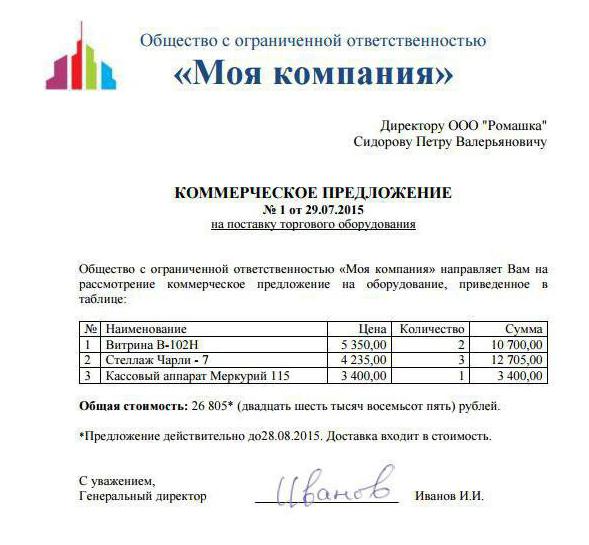Commercial offers - what is it? Examples
There are a variety of ways to promote your business: these are advertising campaigns, and active promotion in social networks. networks, and various gift and bonus programs for their customers, and creating their own websites with a description of services and goods, and influencing people's opinion about the company through various sources of information. Constant promotions and incentives to buy this or that product can in fact be called marketing moves that allow you to create a customer base, collect the necessary data and develop the company, meeting the requirements of your customers. In all areas of any business providing services, there is a need to somehow advertise their product and declare themselves as a good manufacturer. And in these cases, aggressive marketing is not the best way out. Each client is interested in a specific list of services, which can be set out in full only in a well-composed commercial offer, on the basis of which subsequent contracts are concluded.
What is a commercial offer
Every sales manager of any company has encountered in his life the preparation of a commercial offer and knows firsthand what a hassle it really is.
In fact, commercial offers are some documents that you need to send to your partners. If everything is stated correctly and correctly in the document, then a profitable contract is guaranteed for the company. If not, then all the blame falls on the manager who made the specific proposal, because because of him the company loses valuable customers.
Recently, it has been widely believed that commercial offers are a type of modern selling text, which clearly and in detail describes all the services provided by the company, the conditions for obtaining bonuses, discounts and special offers. Well, due to the fact that there is no specific framework for the preparation of a commercial offer as such, it is quite possible that it can be drawn up in free form and have a different structure. The main thing is to bring results, namely, the profit of the company.
Types of commercial offers
Any manager working in a large company knows how to write a commercial proposal. Just like any copywriter can write the appropriate "selling copy". So is there a difference in the first and second case? Of course there is! And it's really huge. As mentioned earlier, in one case this is a standard document, in the other - a well-written text calling for the purchase of a particular product.
Basically, there are two types of commercial offers - personalized and non-personalized. By these names, it is quite easy to guess what exactly the commercial offer drawn up in both cases differs in. A sample of a well-written document will help you not to make mistakes in the main points.
Personification of the offer
A personalized commercial offer is made by company representatives specifically for one client. At the same time, it is important to satisfy his individual needs in the document. In case of successful preparation of a commercial offer, a satisfied client and a good reputation await the company.
Consider the example of a large business. Partners before concluding any contract tend to meet with each other and discuss the details. If one of them is satisfied with the conditions of the other party, then he sends a request for a quotation, which describes the type of services provided, the individual conditions for concluding a transaction and the amount of payment for certain services. Both parties are satisfied. And if one of the parties does not comply with the terms of such a "contract", then the transaction is terminated.

Non-personalized offers
Unlike the first case, non-personalized commercial offers are a way to attract the attention of a new audience. This is the type of those very sales texts, which describe in detail the various advantages of the company and express an incentive to buy the product.
A non-personalized commercial offer, a sample of which, no doubt, everyone has seen, is also called "cold".
A characteristic feature of this proposal is the lack of addressing specifically to a potential client. The text is aimed at a wide audience of people, often of different age categories. It is only needed to attract a new customer base. Doesn't have much uniqueness. It may describe the benefits of the company and one or two conditions for receiving a discount, but nothing more. As a rule, such proposals, written by skilled professionals, attract people.
Functions of a commercial offer
From the above, it is clear that commercial offers are an integral part of an advertising campaign. But what exactly is their function? What should a person experience when reading about a particular company on the Internet or on flyers?
Here are a few criteria that a written commercial proposal must meet:
- draw attention to yourself;
- to interest a potential consumer;
- encourage a person to buy a product;
- push to buy with the help of bonuses, exclusive offers, etc.
Based on these requirements, a commercial offer is drawn up in the future. It is very important to know which audience this document is aimed at, because different generations have different needs.
Therefore, it is foolish to advertise dentures, for example, using tools that are relevant for today's youth. To attract the right audience, a commercial offer must be correctly drawn up. It's not hard to find a sample.
Drawing up a commercial offer, its structure
Mandatory on the form of any commercial offer must be:
- Title: logo of the company providing the service. This will grab the attention of the client.
- Subtitle: Describes the product or service provided by the company.
- Brief advertising of services and conditions.
- Advantages of choosing your company, terms of cooperation, description of the benefits of cooperation.
- Sender's contacts: phone, e-mail, company address.
- Trademarks.
At the same time, in order not to tire the potential client, you should make a commercial offer, the template of which is described above, no longer than 1-2 pages. So there are more chances that the potential client will read the proposal received to the end, and not throw it in the trash already on the first lines.





